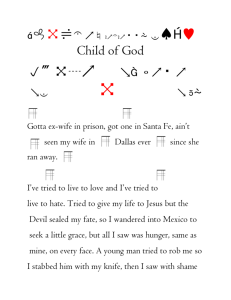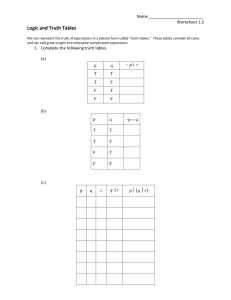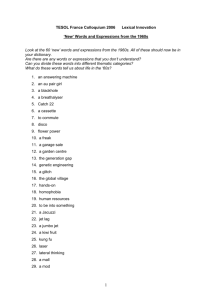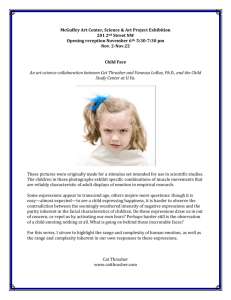Zdroj: DIPLOMOVÁ PRÁCA - Translation of lyrics by Jethro Tull
advertisement
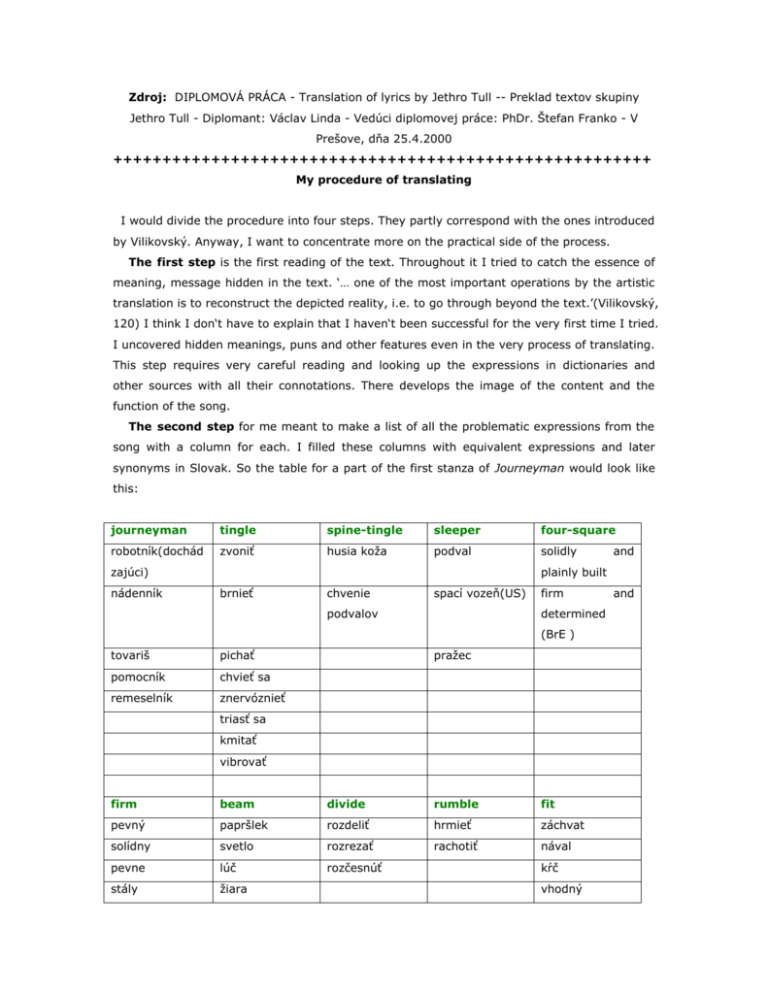
Zdroj: DIPLOMOVÁ PRÁCA - Translation of lyrics by Jethro Tull -- Preklad textov skupiny Jethro Tull - Diplomant: Václav Linda - Vedúci diplomovej práce: PhDr. Štefan Franko - V Prešove, dňa 25.4.2000 +++++++++++++++++++++++++++++++++++++++++++++++++++++++ My procedure of translating I would divide the procedure into four steps. They partly correspond with the ones introduced by Vilikovský. Anyway, I want to concentrate more on the practical side of the process. The first step is the first reading of the text. Throughout it I tried to catch the essence of meaning, message hidden in the text. ‘… one of the most important operations by the artistic translation is to reconstruct the depicted reality, i.e. to go through beyond the text.’(Vilikovský, 120) I think I don‘t have to explain that I haven‘t been successful for the very first time I tried. I uncovered hidden meanings, puns and other features even in the very process of translating. This step requires very careful reading and looking up the expressions in dictionaries and other sources with all their connotations. There develops the image of the content and the function of the song. The second step for me meant to make a list of all the problematic expressions from the song with a column for each. I filled these columns with equivalent expressions and later synonyms in Slovak. So the table for a part of the first stanza of Journeyman would look like this: journeyman tingle spine-tingle sleeper four-square robotník(dochád zvoniť husia koža podval solidly zajúci) nádenník and plainly built brnieť chvenie spací vozeň(US) podvalov firm determined (BrE ) tovariš pichať pomocník chvieť sa remeselník znervóznieť pražec triasť sa kmitať vibrovať firm beam divide rumble fit pevný papršlek rozdeliť hrmieť záchvat solídny svetlo rozrezať rachotiť nával pevne lúč rozčesnúť stály žiara kŕč vhodný and vytrvalo hodiť sa schopný As it is clear from the notes, to the expression four-square, I recorded sometimes also the definitions from the English-English dictionary. It helped me to find the corresponding expressions in Slovak. The process then continued within the third step. There are also noticeable digressions from the original meaning in some expressions (c.f. divide). These words were found already on the level of synonymy or even metonymy. I worked with the dictionaries I have mentioned in the bibliography but sometimes I haven’t found the corresponding expression in these sources and I was left to find the equivalent on my own. It may then take a lot of time and effort to manage. In the third step there begins the actual creative work of translation. The first versions of text arise. At this level the future poems have no rhyme. The most important principle is to transfer the meaning and the images into the target language. The first version of One Brown Mouse then appeared as follows: Istá hnedá myš Smej sa svojím malým smiechom --- zostaň chvíľu na čaj. Stras si ten čierny mrak z pliec. Potras fúzmi. Precíť, že si ozaj ozajstná. Ďalšie popoludnie --- zas o deň starší. Vdýchni si teplý vzduch do drobučkých dlaní. Radšej by si bola človek ten môže každý deň otočiť ďalšiu stranu. Za pohárom si sedíš a hľadíš do mojej večne otvorenej knihy --Hnedá myš sediaca v klietke. Si zvedavá, či ťa ozaj mám rád --Alebo som len tvoja návšteva --Kto z nás kraľuje v starom mlyne --Kto skrýva hlavu, robí sa, že spí? Smej sa svojím malým smiechom --- zostaň chvíľu na čaj. A každý deň otočíme ďalšiu stranu Za naším pohárom budeme sedieť a hľadieť do našej večne otvorenej knihy --Hnedá myš sediaca v klietke. The expressions are translated word for word when possible. So the first line sounds: Smej sa svojím malým smiechom --- zostaň chvíľu na čaj. The little smile is accordingly malý smiech although in the final version it is smiešok. The use of diminutive form is partly demanded by the frequent use of these forms in Slovak texts with the same content and also for the sake of preserving rhyme. There is an internal rhyme in the original: Smile your little smile --- take some tea with me awhile. Smile rhymes with awhile. Then the double use of the word smile plus the use of some creates alliteration. This I had to take into account when approaching the next step. The fourth step takes the most of time and is also the most creative one. I had to contemplate all the features of the text both as to the meaning and the form. It then required careful consideration of all the eventual possibilities. Of course, there were more of them most of the time since the inventory of language is really rich. So, in the case of One Brown Mouse I tried to preserve the euphonic features in my version by the use of words zasmej sa svojím smieškom, all of them containing the hissing sounds that evoke the image of a mouse smiling. The internal rhyme is preserved by the pair smieškom – mliečkom. So the final version sounds: Zasmej sa svojím smieškom --- ponúknem ťa mliečkom. The process continues moreover further on. As I have already mentioned, the translations are not finished. I concentrated myself mainly at the transfer of meaning and imagery, and at the same time I tried to keep the original rhyme pattern. There might be some disagreement in pattern of meter and the amount of syllables in verse although I tried to preserve the number of syllables in my translations. This was but of lower importance for me. I tried to include the whole information and imagery in the final text, so I avoided omission of relevant words and forms. This causes the discrepancies between the meter of original and the translation. In my commentaries, I would therefore not relate to the meter and number of syllables in the translations, but rather concentrate on the other features of the text. I tried to follow the principle that ‘ …the meter cannot be in opposition against the existing, established language system, so that the rhythm may not violate the rules of accent in the language.’ (Slobodník, 45). Whether I achieved it, may be decided by every reader him/herself. The translations should be easy to read and easy to recite. That would be the best proof of my success. I tried to follow the original punctuation, though sometimes I had to insert some commas for the Slovak punctuation rules differ from the English.



